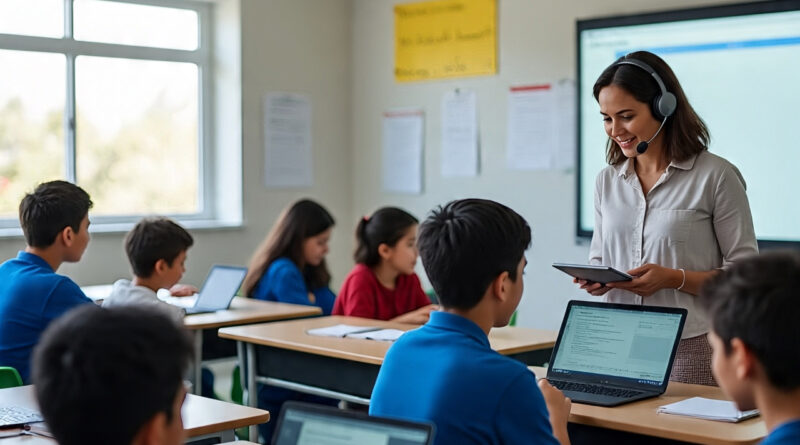How Technology is Transforming the Education System
The 21st century has witnessed technology pervading all walks of life, and education is no exception. It takes the form of e-learning and smart classes to virtual reality and artificial intelligence, and technology is transforming the process of reception, transmission, and storage of information. The traditional classroom model is giving way to more dynamic, volatile, and flexible learning patterns. This has not just created more access to education, but quality and efficiency too.
1. Better Accessibility and Flexibility
The best technology that has helped education the most is that there is greater accessibility.
Individuals can takes good education anywhere because of the availability of the internet and mobiles. Rural kids can get education they otherwise would have missed. At. Online education, ebooks, and study apps made man capable of learning at any location and at any time. It has been of immense benefit to human beings, especially during pandemics like the COVID-19 pandemic, when schools remained shut but online classes ran unabated. The online courses of Coursera, edX, and Khan Academy provided millions of learners across the world with the privilege of learning at home comfortably according to their own pace. Even traditional colleges found it appropriate to use Learning Management Systems like Moodle and Google Classroom to experiment with online learning and communication between teachers and students.
2. Personalized Learning
Technology is able to personalize the learning experience of student by student to his/her unique needs and in what manner they need to learn.
Artificial Intelligence can improve the teacher’s capacity to optimize observation of a single student’s performance and where he or she requires support more effectively. For example, computer adaptive learning systems vary based on the learner’s performance level so that he or she is challenged to a particular level but not to a level where it is simply overwhelming. Along with this, selecting courseware developed as per their learning style—visual, auditory, or kinesthetic—thereby helps them to learn best and also become highly participatory in the classroom. The shift from the one-size-fits-all system to an attuned system is therefore yielding dividends in terms of scholarship and comprehension.
3. Interactive and Participatory Learning Tools
There has been available technology presenting various interactive tools to make learning more enjoyable and effective. Multimedia slideshows, lesson video segments, animations, and educational computer software with games generate higher interest and facilitate acquiring challenging ideas better. Virtual Reality (VR) and Augmented Reality (AR) are able to present simulation-based learning experiences—e.g., studying the human body in 3D or virtual walking tours of ancient monuments.
Gamification—game learning principle—has also been found to enhance the motivation of students. Point, level, and reward systems and schemes like Duolingo employ points, levels, and rewards in the language learning process in an interactive, fun, and exciting manner, and schemes like Kahoot and Quizizz make quizzes into interactive fun and competitive quizzes.
4. Teacher Empowerment and Professional Development
It does not just empower the educators but also the students. Educators now have at their fingertips a treasure trove of material to teach, to develop lessons, and share on the web. Educators can also connect with educators all over the world and share and learn information and best practice.
Professional development opportunity has also been provided in the manner of MOOCs, webinars, and online workshops. Professionals are no longer sitting at home figuring out how to become professionally competent but are designing new pedagogy, classroom management, or content for home.
5. More Assessment and Feedback
Technology has speeded marking. Electronic marking, electronic portfolios, and on-line examinations offer immediate response, on-line teacher and student read-aloud. It eliminates back-aching hand marking and offers space for teacher intervention to be initiated early with under-achievers.
AI subjects even monitor students’ writing compositions on grammar, coherency, and even creative writing and puts pressure to meet more stringent academic levels. Online test data also give schools and policymakers the bargaining power of evidence-based reasoning for making a choice about their curriculum and resource allocation.
6. Challenges and Considerations

Although there are numerous benefits, there are certain disadvantages to technology inclusion. Of concern is where no two individuals have an equal number of PCs and internet. Underdeveloped or rural communities are deprived of infrastructure to utilize online education.
There is also technological dependency, which has reduced human-to-human communication as well as social student development. Addictive screen time, safeguarding information, and the need for digital competency of the teacher and the student are some of the other needs to be addressed.
Conclusion
Technology is actually reshaping the educational system, expanding it in a simpler and student-focused manner. And there are challenges to be overcome, but more room for opening up than closing down. And technology, with its intelligent application and even dissemination, can bridge educational gaps and prepare students to thrive in another world.
Tomorrow’s learning integrates the coming together of classroom learning with the evolving nature of technology-mediated resources. Tomorrow’s future must be inclusive, sustainable, and student-centered.
